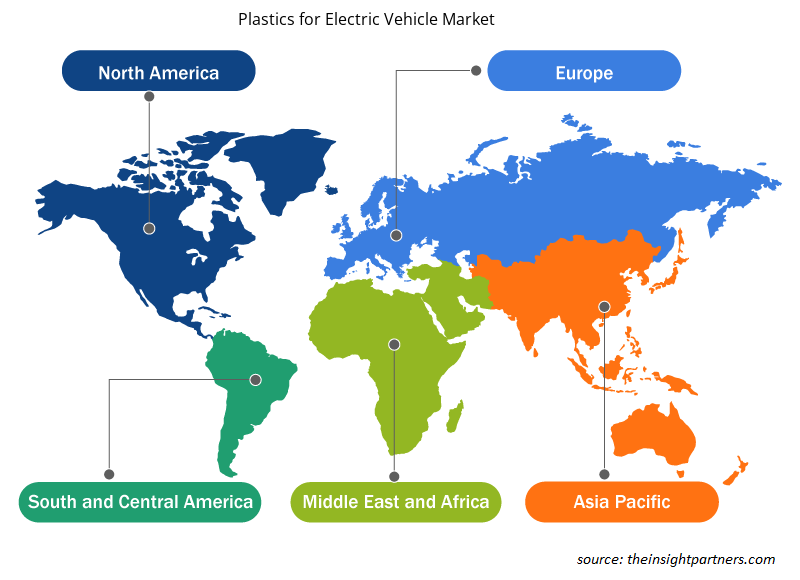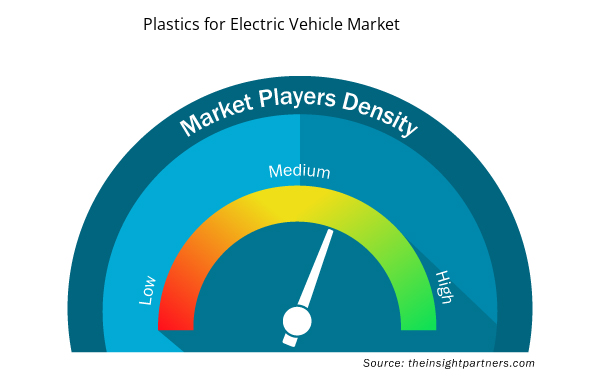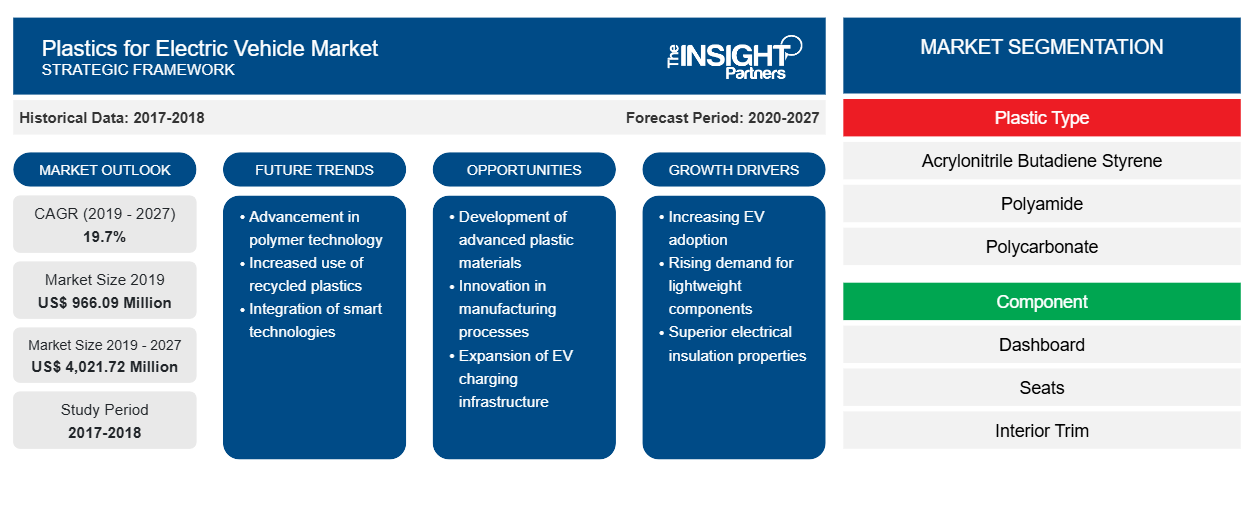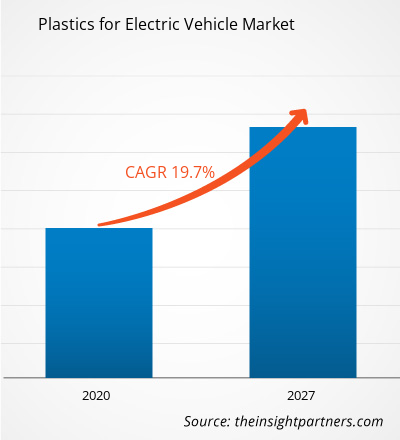بلغت قيمة سوق البلاستيك للسيارات الكهربائية 966.09 مليون دولار أمريكي في عام 2019 ومن المتوقع أن تصل إلى 4،021.72 مليون دولار أمريكي بحلول عام 2027؛ ومن المتوقع أن تنمو بمعدل نمو سنوي مركب قدره 19.7٪ من عام 2020 إلى عام 2027.
يمكن أن تكون المواد البلاستيكية موصلة للكهرباء وعازلة أيضًا. يمكن إنتاج بوليمر اللدائن الحرارية بأشكال وتصميمات مختلفة وفقًا لمتطلبات المركبات الكهربائية نظرًا للتنوع الكبير وسهولة تشكيل البلاستيك. يقلل استخدام البلاستيك للمركبات الكهربائية من وزن هذه المركبات، مما يوفر نطاقًا أكبر بين عمليات إعادة الشحن. توفر المواد البلاستيكية مقاومة ممتازة للحرارة تمكن من بناء حجرات البطاريات وأنظمة التبريد ولا تعيق المتانة والسلامة التي توفرها المركبات الكهربائية. من المتوقع أن ينمو سوق البلاستيك العالمي للسيارات الكهربائية في أمريكا الشمالية بأعلى معدل نمو سنوي مركب بنسبة 20.0٪ خلال الفترة 2020-2027.
تم الإبلاغ عن جائحة كوفيد-19 لأول مرة في مدينة ووهان (الصين) في ديسمبر 2019. واعتبارًا من يونيو 2020، تعد الولايات المتحدة وروسيا والهند وإسبانيا والبرازيل وإيطاليا وفرنسا وألمانيا من بين الدول الأكثر تضررًا من حيث حالات الإصابة الإيجابية بكوفيد-19 والوفيات المبلغ عنها. يؤثر تفشي المرض سلبًا على الاقتصادات والصناعات بسبب عمليات الإغلاق وحظر السفر وإغلاق الشركات. تعد المواد الكيميائية والمواد واحدة من الصناعات الرئيسية في العالم التي تعاني من اضطرابات خطيرة في شكل اضطرابات في سلسلة التوريد وإلغاء الأحداث التكنولوجية وإغلاق المكاتب. تعد الصين مركز التصنيع العالمي وأكبر مورد للمواد الخام لمختلف الصناعات في جميع أنحاء العالم، وهي أيضًا واحدة من أكثر الدول تضررًا من جائحة كوفيد-19. يؤدي إغلاق العديد من المصانع والمصانع في الصين إلى تقييد سلاسل التوريد العالمية وتصنيع وبيع مختلف المنتجات الكيميائية والمواد. وبالتالي فإن التأثير الإجمالي للوباء يحد من نمو سوق البلاستيك للسيارات الكهربائية.
قم بتخصيص هذا التقرير ليناسب متطلباتك
ستحصل على تخصيص لأي تقرير - مجانًا - بما في ذلك أجزاء من هذا التقرير، أو تحليل على مستوى الدولة، وحزمة بيانات Excel، بالإضافة إلى الاستفادة من العروض والخصومات الرائعة للشركات الناشئة والجامعات
- احصل على أهم اتجاهات السوق الرئيسية لهذا التقرير.ستتضمن هذه العينة المجانية تحليلاً للبيانات، بدءًا من اتجاهات السوق وحتى التقديرات والتوقعات.
رؤى السوق
الطلب المتزايد على المركبات الكهربائية يدفع نمو السوق
تتجه صناعة السيارات نحو توليد انبعاثات أقل من الغازات المسببة للانحباس الحراري العالمي وزيادة كفاءة استهلاك الوقود مع التركيز المتزايد على الاستدامة البيئية. ومن بين العوامل التي تدفع الطلب على المركبات الكهربائية في جميع أنحاء العالم الفعالية من حيث التكلفة؛ والاستدامة البيئية؛ والراحة؛ وتبني التكنولوجيا المتقدمة؛ والسياسات الحكومية المختلفة مثل الأسعار التفضيلية، والحوافز لشراء المعدات، والخصومات الكبيرة. ووفقًا لوكالة الطاقة الدولية، تم تسجيل زيادة بنسبة 40٪ على أساس سنوي مع مبيعات 2.1 مليون سيارة كهربائية على مستوى العالم في عام 2019، متجاوزة بشكل كبير مبيعات عام 2018.
رؤى حول أنواع البلاستيك
بناءً على نوع البلاستيك، يتم تقسيم سوق البلاستيك للسيارات الكهربائية إلى أكريلونيتريل بوتادين ستايرين (ABS)، والبولي أميد (PA)، والبولي كربونات (PC)، والبولي فينيل بوتيرال، والبولي يوريثين (PU)، والبولي بروبيلين (PP)، وغيرها. شكلت شريحة البولي بروبيلين (PP) أكبر حصة من السوق في عام 2019. يشير البولي بروبيلين (PP) إلى "بوليمر إضافي" من البلاستيك الحراري يتم إنتاجه عن طريق الجمع بين مونومرات البروبيلين. إنه صلب وبلوري؛ لذلك، يتم استخدامه على نطاق واسع لصنع أشياء مثل صواني التعبئة والتغليف والأجهزة الطبية وغيرها. باعتباره أحد أهم عائلة راتنجات البولي أوليفين، يتم تشكيله وبثقه في أي نوع من البلاستيك يتطلب المرونة والصلابة وخفة الوزن ومقاومة الحرارة.
رؤى المكونات
بناءً على المكونات، يتم تقسيم سوق البلاستيك للسيارات الكهربائية إلى لوحة القيادة والمقاعد والزخارف الداخلية وتنجيد السيارات والمصد وغيرها. شكلت شريحة الزخارف الداخلية أكبر حصة من السوق في عام 2019. يشير الزخارف الداخلية في السيارة الكهربائية إلى المكونات أو الألواح البلاستيكية الموجودة داخل المقصورة. الزخارف الوظيفية والجمالية ذات الميزات الممتعة ضرورية لتوفير تجربة داخلية مثالية.
رؤى حول نوع السيارة
بناءً على نوع السيارة، ينقسم سوق البلاستيك للسيارات الكهربائية إلى BEV وPHEV/HEV. شكلت شريحة BEV أكبر حصة من السوق في عام 2019. تخزن المركبات الكهربائية التي تعمل بالبطاريات أو BEVs الكهرباء على متنها باستخدام حزم عالية السعة من البطاريات. تُستخدم الطاقة الموجودة في البطارية لتشغيل المحرك الكهربائي وغيره من الإلكترونيات على متنها. تُستخدم المواد البلاستيكية في صناعة الموصلات والأغطية للمكونات الكهربائية المطلوبة في المركبات الكهربائية.
رؤى التطبيق
بناءً على التطبيق، يتم تقسيم سوق البلاستيك للسيارات الكهربائية إلى نظام نقل الحركة/تحت غطاء المحرك، والخارجي، والداخلي، والإضاءة والأسلاك الكهربائية. شكلت شريحة الداخلية أكبر حصة من السوق في عام 2019. تُستخدم المواد البلاستيكية عالية الأداء في المركبات الكهربائية لتوفير السلامة والأمان. غالبًا ما يستخدم البولي بروبلين في أجزاء السيارات مثل علب الغاز وألياف السجاد للأرضيات الداخلية. يستخدم البولي فينيل كلوريد في خزانات السيارات ولوحات القيادة بسبب لمسته النهائية الأنيقة. يتم أيضًا إنتاج عجلات القيادة ولوحات القيادة باستخدام بلاستيك أكريلونتريل بوتادين ستايرين أو ABS. يعمل التطبيق الواسع النطاق للبلاستيك في عجلات القيادة والأرضيات الداخلية ووحدات التحكم على دعم نمو سوق البلاستيك للسيارات الكهربائية لشريحة التشطيب الداخلي.
رؤى إقليمية حول سوق البلاستيك للسيارات الكهربائية
لقد قام المحللون في Insight Partners بشرح الاتجاهات والعوامل الإقليمية المؤثرة على سوق البلاستيك للسيارات الكهربائية طوال فترة التوقعات بشكل شامل. يناقش هذا القسم أيضًا قطاعات سوق البلاستيك للسيارات الكهربائية والجغرافيا في جميع أنحاء أمريكا الشمالية وأوروبا ومنطقة آسيا والمحيط الهادئ والشرق الأوسط وأفريقيا وأمريكا الجنوبية والوسطى.

- احصل على البيانات الإقليمية المحددة لسوق البلاستيك للسيارات الكهربائية
نطاق تقرير سوق البلاستيك للسيارات الكهربائية
| سمة التقرير | تفاصيل |
|---|---|
| حجم السوق في عام 2019 | 966.09 مليون دولار أمريكي |
| حجم السوق بحلول عام 2027 | 4,021.72 مليون دولار أمريكي |
| معدل النمو السنوي المركب العالمي (2019 - 2027) | 19.7% |
| البيانات التاريخية | 2017-2018 |
| فترة التنبؤ | 2020-2027 |
| القطاعات المغطاة | حسب نوع البلاستيك
|
| المناطق والدول المغطاة | أمريكا الشمالية
|
| قادة السوق وملفات تعريف الشركات الرئيسية |
|
كثافة اللاعبين في سوق البلاستيك للسيارات الكهربائية: فهم تأثيرها على ديناميكيات الأعمال
يشهد سوق البلاستيك للسيارات الكهربائية نموًا سريعًا، مدفوعًا بالطلب المتزايد من المستخدم النهائي بسبب عوامل مثل تفضيلات المستهلكين المتطورة والتقدم التكنولوجي والوعي المتزايد بفوائد المنتج. ومع ارتفاع الطلب، تعمل الشركات على توسيع عروضها والابتكار لتلبية احتياجات المستهلكين والاستفادة من الاتجاهات الناشئة، مما يؤدي إلى زيادة نمو السوق.
تشير كثافة اللاعبين في السوق إلى توزيع الشركات أو المؤسسات العاملة في سوق أو صناعة معينة. وهي تشير إلى عدد المنافسين (اللاعبين في السوق) الموجودين في مساحة سوق معينة نسبة إلى حجمها أو قيمتها السوقية الإجمالية.
الشركات الرئيسية العاملة في سوق البلاستيك للسيارات الكهربائية هي:
- باسف اس اي
- شركة سولفاي
- شركة دوبونت دي نيمورس
- شركة داو للكيماويات
- شركة إل جي للكيماويات المحدودة
إخلاء المسؤولية : الشركات المذكورة أعلاه ليست مرتبة بأي ترتيب معين.

- احصل على نظرة عامة على أهم اللاعبين الرئيسيين في سوق البلاستيك للسيارات الكهربائية
تقرير يسلط الضوء على
- اتجاهات الصناعة التقدمية في سوق البلاستيك العالمي للسيارات الكهربائية التي تساعد اللاعبين على تطوير استراتيجيات فعالة طويلة الأجل
- استراتيجيات نمو الأعمال التي تتبناها الأسواق المتقدمة والنامية
- التحليل الكمي لسوق البلاستيك للسيارات الكهربائية من 2017 إلى 2027
- تقدير الطلب على البلاستيك في المركبات الكهربائية عبر مختلف الصناعات على مستوى العالم
- تحليل PEST لتوضيح فعالية المشترين والموردين العاملين في السوق
- التطورات الأخيرة لفهم سيناريو السوق التنافسية والطلب على البلاستيك للسيارات الكهربائية
- اتجاهات السوق وتوقعاته والعوامل التي تدفع وتكبح نمو السوق
- فهم الاستراتيجيات التي تدعم نمو سوق البلاستيك العالمي للسيارات الكهربائية، مما يساعد أصحاب المصلحة في اتخاذ القرار
- حجم سوق البلاستيك للسيارات الكهربائية في مختلف مناطق السوق
- نظرة عامة مفصلة وتقسيم السوق وديناميكيات الصناعة
- حجم السوق العالمية للبلاستيك المستخدم في المركبات الكهربائية في مناطق مختلفة مع فرص نمو واعدة في هذه المناطق
سوق البلاستيك للسيارات الكهربائية، حسب نوع البلاستيك
- أكريلونيتريل بوتادين ستايرين
- بولي أميد
- بولي كربونات
- بولي فينيل بوتيرال
- البولي يوريثين
- البولي بروبلين
- آحرون
سوق البلاستيك للسيارات الكهربائية، حسب المكونات
- لوحة القيادة
- المقاعد
- الزخرفة الداخلية
- تنجيد السيارات
- المصد
- آحرون
سوق البلاستيك للسيارات الكهربائية، حسب نوع السيارة
- بى إي في
- سيارة كهربائية هجينة/سيارة كهربائية هجينة
سوق البلاستيك للسيارات الكهربائية، حسب التطبيق
- نظام نقل الحركة/تحت غطاء المحرك
- الخارج
- الداخلية
- الإضاءة والتمديدات الكهربائية
نبذة عن الشركة
- باسف اس اي
- شركة سولفاي
- شركة دوبونت دي نيمورس
- شركة داو للكيماويات
- شركة إل جي للكيماويات المحدودة
- شركة لانكسيس ايه جي
- سابك
- شركة كوفسترو
- شركة أساهي كاساي
- شركة ليونديل باسيل للصناعات القابضة بي في
- التحليل التاريخي (سنتان)، السنة الأساسية، التوقعات (7 سنوات) مع معدل النمو السنوي المركب
- تحليل PEST و SWOT
- حجم السوق والقيمة / الحجم - عالميًا وإقليميًا وقطريًا
- الصناعة والمنافسة
- مجموعة بيانات Excel



Report Coverage
Revenue forecast, Company Analysis, Industry landscape, Growth factors, and Trends

Segment Covered
This text is related
to segments covered.

Regional Scope
North America, Europe, Asia Pacific, Middle East & Africa, South & Central America

Country Scope
This text is related
to country scope.
الأسئلة الشائعة
In 2019, Asia Pacific held the largest share of the global plastics for electric vehicles market. The demand for plastics for electric vehicles is expected to increase in the region with the increase in the educated population who demand for more and more electric vehicles. The rise in disposable income and per capita consumption supports the market growth. The rising production capacities of the manufacturers of plastics favors the growth of plastics for electric vehicles market in the region. Continuous innovations in the application of plastics for electric vehicles is yet another factor driving the demand for plastics for electric vehicles. Besides these, rising awareness about the benefits of electric vehicles and initiatives taken by the Government for supporting the demand for plastics for electric vehicles, provides lucrative opportunity for the development of plastics for electric vehicles market in Asia Pacific.
The growth of polyurethane segment is primarily attributed to the fact that polyurethane (PU) is considered to be one of the most versatile plastic materials. It is formed by the reaction of polyol along with a di- isocyanate or a polymeric isocyanate in the presence of an additive or a catalyst. Polyurethane structure comprises of three complex monomers namely, diisocyanate, a macrodial and chain extender, on the basis of which many polyurethane materials can be synthesized. The polyurethane polymers are also characterized by the presence of urethane linkage. Depending on the length and nature of the hydroxyl and isocyanate molecule, the thermoplastic, hard, soft, flexible and cellular type of polyurethane is synthesized. The resultant structure resembles that of polyamide as both of them comprises of CONH groups. Polyurethane possess versatile properties like toughness, biocompatibility and durability that can be tailored depending on the application. In electronic vehicles, the engineers prefer using thermoset polyurethane adhesives for the purpose of bonding the dissimilar materials to the frame of cars. These adhesives are strong and helps in reducing the need for heavy and bulky bolts & rivets. They also help in keeping down the weight of the vehicle curb thus making the cars light & fast along with excellent charge range. Polyurethane is also used in shock absorption components in vehicles. The automakers also prefer using cast polyurethane in muffler systems. It is extensively used in electric vehicle car batteries and provide smoothest driving experience. All these factors are responsible for polyurethane segment to grow at the high rate.
The major players operating in the global plastics for electrical vehicle market are BASF SE, Solvay S.A., DuPont de Nemours, Inc., The Dow Chemical Company, LG Chem Ltd, Lanxess AG, Sabic, Covestro AG, Asahi Kasei Corporation and LyondellBasell Industries Holdings B.V.
Trends and growth analysis reports related to Chemicals and Materials : READ MORE..
The List of Companies - Global Plastics for Electric Vehicle Market
- BASF SE
- Solvay S.A.
- DuPont de Nemours, Inc.
- The Dow Chemical Company
- LG Chem Ltd
- Lanxess AG
- Sabic
- Covestro AG
- Asahi Kasei Corporation
- LyondellBasell Industries Holdings B.V
The Insight Partners performs research in 4 major stages: Data Collection & Secondary Research, Primary Research, Data Analysis and Data Triangulation & Final Review.
- Data Collection and Secondary Research:
As a market research and consulting firm operating from a decade, we have published and advised several client across the globe. First step for any study will start with an assessment of currently available data and insights from existing reports. Further, historical and current market information is collected from Investor Presentations, Annual Reports, SEC Filings, etc., and other information related to company’s performance and market positioning are gathered from Paid Databases (Factiva, Hoovers, and Reuters) and various other publications available in public domain.
Several associations trade associates, technical forums, institutes, societies and organization are accessed to gain technical as well as market related insights through their publications such as research papers, blogs and press releases related to the studies are referred to get cues about the market. Further, white papers, journals, magazines, and other news articles published in last 3 years are scrutinized and analyzed to understand the current market trends.
- Primary Research:
The primarily interview analysis comprise of data obtained from industry participants interview and answers to survey questions gathered by in-house primary team.
For primary research, interviews are conducted with industry experts/CEOs/Marketing Managers/VPs/Subject Matter Experts from both demand and supply side to get a 360-degree view of the market. The primary team conducts several interviews based on the complexity of the markets to understand the various market trends and dynamics which makes research more credible and precise.
A typical research interview fulfils the following functions:
- Provides first-hand information on the market size, market trends, growth trends, competitive landscape, and outlook
- Validates and strengthens in-house secondary research findings
- Develops the analysis team’s expertise and market understanding
Primary research involves email interactions and telephone interviews for each market, category, segment, and sub-segment across geographies. The participants who typically take part in such a process include, but are not limited to:
- Industry participants: VPs, business development managers, market intelligence managers and national sales managers
- Outside experts: Valuation experts, research analysts and key opinion leaders specializing in the electronics and semiconductor industry.
Below is the breakup of our primary respondents by company, designation, and region:

Once we receive the confirmation from primary research sources or primary respondents, we finalize the base year market estimation and forecast the data as per the macroeconomic and microeconomic factors assessed during data collection.
- Data Analysis:
Once data is validated through both secondary as well as primary respondents, we finalize the market estimations by hypothesis formulation and factor analysis at regional and country level.
- Macro-Economic Factor Analysis:
We analyse macroeconomic indicators such the gross domestic product (GDP), increase in the demand for goods and services across industries, technological advancement, regional economic growth, governmental policies, the influence of COVID-19, PEST analysis, and other aspects. This analysis aids in setting benchmarks for various nations/regions and approximating market splits. Additionally, the general trend of the aforementioned components aid in determining the market's development possibilities.
- Country Level Data:
Various factors that are especially aligned to the country are taken into account to determine the market size for a certain area and country, including the presence of vendors, such as headquarters and offices, the country's GDP, demand patterns, and industry growth. To comprehend the market dynamics for the nation, a number of growth variables, inhibitors, application areas, and current market trends are researched. The aforementioned elements aid in determining the country's overall market's growth potential.
- Company Profile:
The “Table of Contents” is formulated by listing and analyzing more than 25 - 30 companies operating in the market ecosystem across geographies. However, we profile only 10 companies as a standard practice in our syndicate reports. These 10 companies comprise leading, emerging, and regional players. Nonetheless, our analysis is not restricted to the 10 listed companies, we also analyze other companies present in the market to develop a holistic view and understand the prevailing trends. The “Company Profiles” section in the report covers key facts, business description, products & services, financial information, SWOT analysis, and key developments. The financial information presented is extracted from the annual reports and official documents of the publicly listed companies. Upon collecting the information for the sections of respective companies, we verify them via various primary sources and then compile the data in respective company profiles. The company level information helps us in deriving the base number as well as in forecasting the market size.
- Developing Base Number:
Aggregation of sales statistics (2020-2022) and macro-economic factor, and other secondary and primary research insights are utilized to arrive at base number and related market shares for 2022. The data gaps are identified in this step and relevant market data is analyzed, collected from paid primary interviews or databases. On finalizing the base year market size, forecasts are developed on the basis of macro-economic, industry and market growth factors and company level analysis.
- Data Triangulation and Final Review:
The market findings and base year market size calculations are validated from supply as well as demand side. Demand side validations are based on macro-economic factor analysis and benchmarks for respective regions and countries. In case of supply side validations, revenues of major companies are estimated (in case not available) based on industry benchmark, approximate number of employees, product portfolio, and primary interviews revenues are gathered. Further revenue from target product/service segment is assessed to avoid overshooting of market statistics. In case of heavy deviations between supply and demand side values, all thes steps are repeated to achieve synchronization.
We follow an iterative model, wherein we share our research findings with Subject Matter Experts (SME’s) and Key Opinion Leaders (KOLs) until consensus view of the market is not formulated – this model negates any drastic deviation in the opinions of experts. Only validated and universally acceptable research findings are quoted in our reports.
We have important check points that we use to validate our research findings – which we call – data triangulation, where we validate the information, we generate from secondary sources with primary interviews and then we re-validate with our internal data bases and Subject matter experts. This comprehensive model enables us to deliver high quality, reliable data in shortest possible time.


 احصل على عينة مجانية لهذا التقرير
احصل على عينة مجانية لهذا التقرير